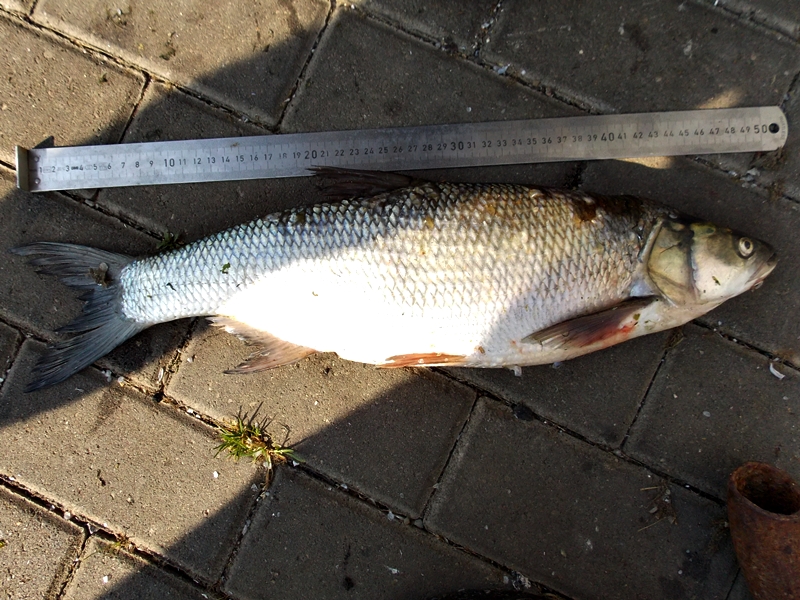Asp
- Category: Fish fauna - species
- Published: Wednesday, 26 October 2016 11:23
- Written by Super User
Asp
Aspius aspius Linnaeus, 1758
Species description
Asp is a fish belonging to the cyprinid family. It can reach over one meter length and weigh up to several kilograms. Its body is elongated, slightly flattened at the sides, covered with cycloid scales (photo. 1.). This species has a big head with mouth reaching up behind the right corner of the eye. Dorsal and tail fins are grey and blue with darker edges, while pelvic, pectoral and anal fins are red.

Asp is a species of the European Community interest and therefore it is listed in the Annex II of the Habitat Directive (Council Directive 92/43/EEC of 21 May 1992 on the conservation of natural habitats and of wild fauna and flora). It is not protected according to the Polish legislation.
Biology
Asp is a long-lived species. The oldest specimen caught in Poland was 16 years old (Trzebiatowski and Leszczewicz 1976). At the age of 4-5, asp is sexually mature. Asp roe is sticky and of 1.3-1.7 mm in diameter. Depending on the size of the fish the female lays from 19 to 400 thousand eggs. In order to spawn which takes place in early spring, asp migrates to the upper, faster flowing part of the river. During the spawning period sexual dimorphism is noticeable. Males have a pearl rash on the bronchial cover and pectoral fins. Female lays eggs on the pebbly-stony bed of a river with fast currents (Gąsowska 1962). Larval stage lasts from 23 to 25 days. After 5 to 10 days, juvenile individuals start feeding.
Asp is a predator. Depending on the development stage, it feeds on rotifer, zooplankton, Copepoda and Cladocera. At the age of 2, its diet consists mainly of small cyprinidal fish: bleak (Alburnus alburnus), roach (Rutilus rutilus), chub (Squalius cephalus) and gudgeon (Gobio sp). While feeding, which takes places during the day, asp stunts its prey by hitting the water surface with tail (Tarlecki et al. 1990).
Asp is solitary. It takes spawning, winter and food migrations, most intensively in May and June.
Due to the fact that asp is a species of economic importance, its population is affected by fishing and stocking.
Habitat
Asp inhabits flowing and standing waters such as lakes and reservoirs. Environmental conditions in central parts of plain rivers are suitable for asp. It can be found in brackish waters, e.g. in estuaries or in lagoons. This predator prefers clear, passable waters what make the feeding and migrating easier.
Distribution
Asp is a common species occurring in all large Polish rivers. It lives in the majority of Vistula River catchment – such as Dunajec River, San River, Tysmienica River, Biebrza River, Narew River, Bug River, Drwęca River and Pilica River.
Asp is monitored at 6 sites, within the framework of the project ”Pilot monitoring studies of marine habitats and protected species in 2015-2018”:
- Jezioro Łebsko,
- Jezioro Gardno,
- Zalew Szczeciński,
- Jezioro Resko Przymorskie,
- Wisła Śmiała,
- Jezioro Bukowo.
References
- Gąsowska M. 1962. Wszystko o boleniu. Boleń, rap (Aspius aspius L.). Wiadomości wędkarskie 4: 12-14.
- Tarlecki J., Tadajewska M., Szczyglińska A. 1990. Odżywianie się ryb gatunków cennych gospodarczo w zbiorniku Zegrzyńskim oraz ich wewnątrz i międzygatunkowe zależności. (in:) Kajak Z. (ed.). Funkcjonowanie ekosystemów wodnych ich ochrona i rekultywacja. Część I. Ekologia zbiorników zaporowych i rzek. SGGW-AR, Warszawa, p. 126- 162.
- Trzebiatowski R., Leszczewicz T. L. 1976. A contribution to knowledge of biology and economic importance of Aspius aspius L. of the Szczecin Firth. Acta Ichtiologica et Piscatoria 6:103-118.





